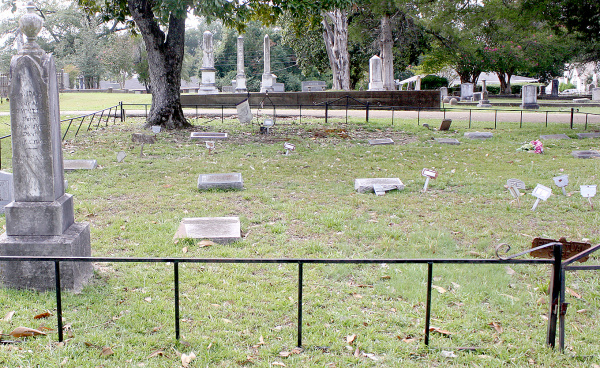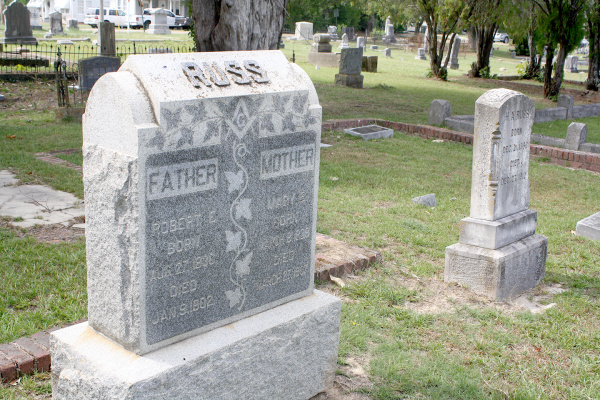Greenwood Cemetery goes online

Leader photos by Nancy Bergeron Greenwood Cemetery, with its main entrance on Alabama Avenue, began when Ruston founder Robert E. Russ donated land for a “public burying ground.” Now the names of the more than 4,000 people buried there are on a searchable database on Ruston’s website, ruston. org.

A children’s plot. Many of the graves are unidentified, marked only by metal plates bearing no names. Some are marked with the word “Infant.”

Ruston founder Robert E. Russ is buried in Greenwood Cemetery. The cemetery is filled with people who, from the founding of the town to present, have contributed to Ruston’s cultural, educational, civic, economic, religious, and physical growth.
More than 4,200 people, many whose names are synonymous with the founding and growth of the city of Ruston, are buried within blocks of the center of the community they helped bring to life.
Now, for the first time in the 137-year existence of Greenwood Cemetery, genealogy researchers, family members, and anyone interested in Ruston’s history can learn who’s buried in the cemetery, where, and for most of the deceased, when they were born and when they died.
The up-to-date list of the 4,292 names is accessible through a new Greenwood Cemetery page on the city’s website, ruston.org.
The page is located under the “Visitors” tab and includes a spreadsheet of names; dates of birth and death, where known; and plot, block, and lot number of their gravesite. The page went live last week.
“People were looking for relatives and didn’t know where to start,” said Charlene Willis, Ruston’s facilities booking coordinator and now keeper of the cemetery records.
Contrary to long- held belief, Ruston does not own Greenwood Cemetery, though it does mow and edge the 30-acre site that fronts on West Alabama Avenue.
The cemetery is owned by the people who bought the 30-foot-by-30-foot blocks into which the burial ground is divided.
For years, the city’s kept cemetery records of sorts — some are in threering binders, others on index cards. The records appear to have moved among several city departments over the years before coming to rest at City Hall.
Early this spring, Willis was asked if she’d like to take them over and figure out how to get the information online. A history buff, Willis jumped at the opportunity.
“I love history, and I loved doing this because I knew so many people in Ruston,” she said.
It took about three months to key in the 4,000-plus names and accompanying data.
Records in the Lincoln Parish Courthouse show Ruston founder Robert E. Russ donated the cemetery site for a “public burying ground” in July 1886, two years after the town was incorporated.
The act of donation and dedication of the cemetery was accepted by J. J. Neilson, Ruston’s first mayor, and witnessed by Eugene Howard and T.B. Finley.
Russ, Neilson, Howard, and Finley are all buried in Greenwood Cemetery.
So are other figures from the city’s history: Police Chief Tom Sisemore, killed in the line of duty in 1898, members of the instrumental Davis, James, and Colvin families, and legendary Ruston High School football coach L. J. “Hoss” Garrett.
The original cemetery along Everett Street and Alabama Avenue was fenced. The oldest graves are located there. The entire site is on a hill, and many of the graves are terraced.
At some point, the town divided the cemetery into plots. Each plot is divided into four 30x30 blocks, and each block into four 15x15 lots.
Each lot was intended to hold three graves. In 1886, a single gravesite cost $25.
Once a block was sold, the sale was supposed to have been recorded at the courthouse, and the property became that of the buyer.
Over the years, the cemetery has extended northward several times. It stretches from the entrance on Alabama Avenue on the south to Calcote Avenue on the north, and Everett Street on the west to slightly past Colvin Street on the east and is adjacent to both the Louisiana Tech University and RHS campuses.
In 1999, the cemetery was surveyed by a local Boy Scout troop for an Eagle Scout project. The scouts mapped the location of each memorial.
Evidently, part of Greenwood Cemetery was a burial site before the Russ donation, or remains were disinterred from elsewhere and reburied at Greenwood.
That seems to the story of Civil War soldier George Hearne, who died in 1862 but is buried in Greenwood Cemetery.
Hearne was a private in the Confederate Army’s Bossier Cavalry. According to an online history of the cavalry, Hearne died in service on June 9, 1862, near Camp Priceville, Mississippi, and evidently was initially buried there.
Hearne’s is one of 17 graves in the oldest area of Greenwood Cemetery that predate 1886, the year of the cemetery’s donation and dedication.
There are 72 Civil War veterans interred in the cemetery, 49 of whom are known and 23 ofwhom are unknown.
In the same area is a block filled with graves of children, many of which are marked only with metal signs and no name. Others say “Infant” and a last name or date. Many of the youngsters were thought to have been from the Methodist Children’s Home, during its days as an orphanage.
Likely more children are buried there who died a birth or as infants and no marker were erected, according to cemetery lore.
In fact, there are so many unmarked graves in the cemetery that sometimes when a new grave is opened, an old one is unearthed, officials said.
There aren’t any lots available in Greenwood Cemetery, Willis said. That doesn’t mean every gravesite is filled, simply that they are all spoken for. And will in time speak a history of their own.

